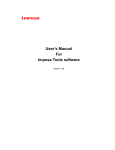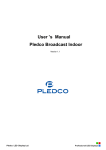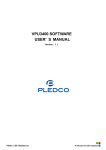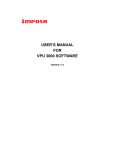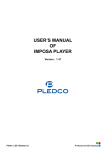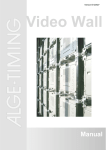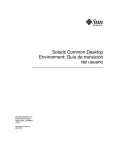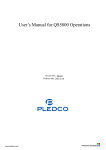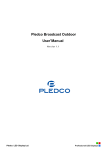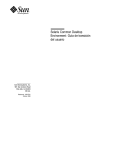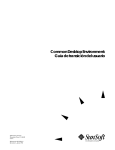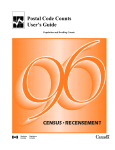Download Imposa Tools software For User`s Manual
Transcript
User's Manual For Imposa Tools software Version:v1.2 www.pledco.com Revision History Revision Date of Revision Description Revised by 1.0 2006-11-24 This is the first edition. Sureone 1.1 2006-12-18 Modified support connection address. Sureone 1.2 2006-12-26 Updated the Imposa Tools software. Sureone 1 www.pledco.com Table of Contents 1.TERMS AND DEFINITIONS..................................................................................................1 2.INTRODUCTION TO THE FUNCTIONS OF THE SOFTWARE .....................................1 3.OPERATION ENVIRONMENT ........................................................................................................1 3.1 System Requirements..............................................................................................................1 3.2 Connecting the Equipment......................................................................................................1 4.STARTUP ..................................................................................................................................1 4.1 4.2 Preparing for startup ..........................................................................................................1 Startup ...............................................................................................................................1 5.INTRODUCTION TO THE SOFTWARE INTERFACE .....................................................2 5.1 Interface Introduction of the Imposa Tools .............................................................................2 5.2 Menu Bar ................................................................................................................................3 5.3 Setting Bar ..............................................................................................................................4 5.4 LDU Management Bar.................................................................................................................4 5.5 Status Bar..................................................................................................................................4 6.EXPLANATIONS ON BASIC OPERATIONS ......................................................................5 6.1 Managing the LDU .................................................................................................................5 6.2 Saving or Opening a Project File ............................................................................................7 6.3 Adjusting Time........................................................................................................................9 6.4 Testing the Serial Ports..........................................................................................................10 6.5 Setting the Parameters for the LDU ......................................................................................11 6.6 Setting the Parameters of the Screen.....................................................................................14 6.7 Basic Information of the LDU, Basic Color Adjustment and Display Test...........................18 6.8 Equipment Test......................................................................................................................22 7.EXPLANATIONS ON ADVANCED OPERATIONS ..........................................................23 7.1 Backup and Restoration ........................................................................................................23 7.1.1 Backup LDU data...................................................................................................................24 7.1.2 Recover ................................................................................................................................26 7.1.3 Backup Config Files for All Display Tiles ...................................................................................28 7.2 Repair and Upgrading ...........................................................................................................28 7.2.1 Upgrading software ................................................................................................................29 7.2.2 Read back the data ................................................................................................................30 7.2.2 Repairing ..............................................................................................................................31 7.3 Guide to Repairing ................................................................................................................32 2 www.pledco.com 1.Terms and Definitions z VPU3000:Video Process Unit z LDU3000:LED Distribute Unit z Pledco ® cabinet: The exterior dimensions of the cabinet are fixed. Each cabinet is matched with 6 display modules. Each module has various rows and columns of pixels that make up the resolution, while the pixels are situated at certain distances which we call Pitches. Different pitches lead to different specifications. Display module:The modules are made up of light emitting diodes, driving circuits and front masks. The modules are z potted with high performance silicon. The module is the basic element of an LED display. 2.Introduction to the Functions of the Software 2.1 To detect and set the size, display mode, driver board type, and color temperature, etc. of the LED display. 2.2 To detect the status of various Pledco™ cabinets. 2.3 To test the LED display. 2.4 To read back, upgrade and repair the data on firmware, GAMMA data, configuration files, data for driver boards. 2.5 Advanced hardware backup and restoration. 2.6 To test system communication and computer serial ports. 3.Operation Environment 3.1 System Requirements z Intel Pentium or Celeron MAX 500 MHz CPU or higher or compatible system z RAM:128 M or more z Available USB port or serial port (RS232) z 10/100M Ethernet z CD-ROM drive z Windows 2000, windows XP and windows 2003 operate system z Displaying mode: 1024X768, 24 Byte at least 3.2 Connecting the Equipment 3.2.1 Offline Display LDU, Pledco ™ cabinets, light sensor Unless one or more Pledco™ cabinets are connected, some of the functions may not be able to perform normally. 3.2.2 Synchronous Display When in synchronous mode, the following equipment or instruments should be added to avail normal operation VPU3000, one pair of optic converters, video source (e.g., DVD player or other video equipment), DVI input (as computers have DVI outputs) 4.Startup 4.1 Preparing for startup Properly connect the equipment and the computer. If you want to connect a computer via USB to the VPU, please refer to “Universal converter winxp A3 20060901.pdf”, and install the driver software for converting USB to serial communication. 4.2 Startup Choose Start\All programs\Imposa software\Imposa Tools, or double clickImposa Tool. exe To the software, you must log in. The Login window is as the following Fig. 4.1. www.pledco.com Fig. 4.1 Imposa Tools Login Window Please input Password in the box after Password. If this box is selected, the software will remember the password you have input so that next time when you log in, you don’t have to input the password. To exit. After logging in, you will see the software interface as shown in the following Fig. 5.1 5.Introduction to the Software Interface 5.1 Interface Introduction of the Imposa Tools After the software Imposa Tools have been started, you will see the following (See: Fig. 5.1): 2 www.pledco.com Fig. 5.1 Main interface of Imposa Tools 5.2 Menu Bar As Fig. 5.1 area 1 shows, the Menu Bar has four menus: File, View, Tool and Help. Fig. 5.2 Menu Bar Menu Bar supports the same shortcut operation with Windows. One can press “Alt +the first letter of the menu name”. See Tab. 5.1. Menu Name File View Tool Help Table 5.1 Shortcut key of Menu Bar Shortcut key Alt + F Alt + V Alt + T Alt + H 5.2.1 File menu includes: Open Project, Save Project and Exit. Fig. 5.3 File menu Save Project serves as saving the communication parameter and basic parameter on the current project. Open Project is to open the project file saved before. Exit means exit from the Imposa Tools software. 5.2.2 View menu includes: Tile Information, LDU Setting, Screen Setting, Device Check, and Maintenance. Choose different buttons to switch to different setting windows. Fig. 5.4 View menu 5.2.3 Tool menu includes: Maintenance Wizard, Adjust Time, Serial Check, Backup LDU Data, Recover, Backup Config Files of All Tiles. Fig. 5.5 Tool menu ♦ Maintenance Wizard: Maintenance guide for operation. ♦ Adjust Time: To adjust the time of the display. 3 www.pledco.com ♦ Serial Check: Serial port for check. ♦ Backup LDU Data: For Backup of LDU data. ♦ Recover: To recover LDU data. ♦ Backup Config. Files of All Tiles: For backup of config files of all tiles. 5.2.4 Help menu only comprise About. Fig. 5.6 Help menu Select ”Help\About”, and the instructions to the software edition will appear ,see Fig. 5.7. Click anywhere of the window to exit the window. Fig. 5.7 About window 5.3 Setting Bar Area 2 in Fig. 5.1 is just the Setting Bar. Select different buttons to switch to different setting windows. The functions are the same with View. Setting window is in area 4 in Fig. 5.1. Fig. 5.8 Pledco Tools 5.4 LDU Management Bar LDU Management Bar is in the area 3 in Fig. 5.1. One can add or delete LDU, set LDU’s communication parameters and even refresh them. Fig. 5.9 LDU Management Bar 5.5 Status Bar Status Bar is in the area 5 in Fig. 5.1. 4 www.pledco.com Fig. 5.10 Status Bar Status Bar illustrates the firmware version of LDU. CPU Version is CPU’s version number, and FPGA Version is FPGA’ version number. In Fig. 5.10, CPU’s version number is AF22, and FPGA’ version number is 8081. ♦ The window is refreshed only after Status Bar is switched to Screen Setting. 6.Explanations on Basic Operations 6.1 Managing the LDU Through LDU Management Bar, one can add or delete LDU, set LDU’s communication parameters and even refresh them. NOTE: What is shown in LDU Management Bar is the LDU corresponding address. If it is the first time to operate the Pledco Tools, there will be no LDU in LDU Management Bar, as is shown in Fig. 6.1. In th is case, one should press to add the LDU HUBs according to the actual screen composition. One display can be made up of several LDUs, but they should be added one by one at a time, and can not be added all at once. Fig. 6.1 LDU Management Bar when Pledco Tools is operated for the first time. 6.1.1 Add LDU Press and there will appear a window as Fig. 6.2. Set the communication parameters according to the actual connection of LDU. Fig. 6.2 Communication parameter setting for LDU When computer and LDU communicate with each other via RS232/485 or VPU, choose RS232/485 and select the correct serial port and baud rate in Com Port. See Fig. 6.3. 5 www.pledco.com PIC 6.3 Selects serial port and the related baud rate. When computer and LDU communicate with each other via Ethernet, choose Ethernet and input the connect IP address (169.254.10.49, for example) in IP bar. See Fig. 6.4. PIC 6.4 Selecting Ethernet and input IP address Note: If it is an off-line display, one can choose RS232,RS485 or Ethernet as the communication means between computer and LDU. For baud rate can range from 2400Bps to 115200Bps. When used as a synchronous display, the communication between computer and LDU is realized by an optic fiber cable. In this case, only USB (USB switch to RS232) or RS232 can be used. The baud rate will be switched to 19200Bps automatically. For the HUB Address, the option varies from F0 to F7. Set it according to the LDU’s actual connections. Fig. 6.5 Select LDU Address Press to finish adding an LDU. Then the LDU Management Bar will turn to the following window. For the newly added LDU, the address is F0, serial port is COM3, and baud rate is 19200Bps. Fig. 6.6 Adding one LDU 6.1.2 To delete an LDU Press to delete a LDU, as shown in Fig. 6.7, a confirmation window will appear. Press to cancel the operation. 6 www.pledco.com to delete it, and Fig. 6.7 To confirm deletion 6.1.3 Setting the communication parameters for the added LDU Press to have Fig. 6.2 to come out. Set the communication parameters according to actual connections of LDU. Double click a certain LDU and there will also appear Fig. 6.2. 6.1.4 Rrefresh information of the added LDU Press to have Fig. 6.8 to come out. It means the software is reading LDU’s information. After reading, the information will be shown in the setting window in area 4, as Fig. 5.1 shows. Fig. 6.8 Reading LDU’s information 6.1.5 To minimize LDU Management Bar Press to Minimize LDU Management Bar. Press it again to resume full size. The minimized LDU Management Bar is shown as in Fig. 6.9. Fig. 6.9 Minimized LDU Management Bar 6.2 Saving or Opening a Project File 6.2.1 Save the current project file Select File\Save Project to a file, Project1, for example, and press Save. The suffix is cpj. 7 www.pledco.com Fig. 6.10 Name the project file 6.2.2 To open a saved project file Select File\Open Project, and you will see a prompt as shown in Fig. 6.11a. Open the new project file and the current project will be overwritten. You may press Yes to continue or No to exit. Fig. 6.11a Whether to continue opening a new file or not. Choose the saved project file, say Project1, and press Open it. The suffix is cpj. 8 www.pledco.com PIC 6.11b To open a saved project file 6.3 Adjusting Time Select Tool\Adjust time, and there will appear a window as shown Fig. 6.12. Fig. 6.12 Window of adjusting time The software will read the date, time and time zone of the connected LDU, and show them in the Display bar. The date, time and zone of the computer will be shown in the Computer bar. Read the date, time and time zone of the connected LDU, and show them in the Display bar. Adjust time. Send the computer’s date, time and time zone to the connected LDU. If the adjusting is successful, a window as shown in Fig. 6.13 will appear. Or if failed a failure prompt will come out. 9 www.pledco.com Fig. 6.13 Time adjusted successfully. Close the current window 6.4 Testing the Serial Ports Select Tool\Serial Check to have Fig. 6.14 to come out. This test can check if the serial port of the computer is normal. Before the test, connect the red joint attached with LDU to the serial port that needs testing. Prepare the universal adaptor switching USB to RS232 to check USB port. Fig. 6.14 Window of Checking a Serial Port 6.4.1 Select a serial port and set its parameters Choose the serial port to be tested. Set the baud rate of the serial port to be tested. 6.4.2 Starting and finishing testing After selecting the serial port and baud rate, press button Start to start the test. The result will be shown in the Message window( Fig. 6.15) of Check Serial Port ,Fig. 6.14. 10 www.pledco.com Fig. 6.15 Message window of Check Serial Port Press it to stop the test. Delete the information in Message window. Close the testing window. 6.4.3 Meanings of the results It means the serial port works abnormally. It means the serial port is normal. 6.5 Setting the Parameters for the LDU Select or View\LDU Setting in the setting bar of Pledco Tools to switch to LDU Setting window, See Fig. 6.16. Fig. 6.16 LDU Setting window 6.5.1 Basic Setting Set the X and Y coordinates of LDU. Only valid for synchronous displays. 11 www.pledco.com Set the size of the display controlled by the LDU HUB. The setting should be on the basis of the display’s actual composition. When setting, one can press the number keys on the keyboard directly or click at the right of the input box to add or decrease the number. 6.5.2 Communication Setting Set the IP address of LDU HUB when using Ethernet to communicate. Set the baud rates of COM1 and COM2 on LDU HUB, Baud Rate 1 should correspond with COM1, and Baud Rate 2 with COM2. The default baud rate is 115200Bps. 6.5.3 Advanced Setting Set the number of Pledco™ cabinet connected to the LDU HUB. 6.5.4 Color Adjustment Adjust the color temperature of the display. Set it to be 6500K,9300K or Preset. The set value will be shown on the display immediately. Set the color temperature when at 6500K. When setting, one can press the number keys on the keyboard directly or click at the right of the input box to add or decrease the number. Set the color temperature when at 9300K. Set the color temperature when preset. 6.5.4 Color Adjusting during operation Set the color temperature of the display synchronously. Press to open the Dynamic Color Adjusting window . see Fig. 6.17. 12 www.pledco.com Fig. 6.17 DynamicColor Adjusting window The value of color temperature of the display set in this window can be shown forthwith, but it can’t be saved in config files. One minute later after setting, the display will return to the original value. When adjusting the ratio of the three colors so as to change the display’s color temperature, one can press the number keys on the keyboard directly or click at the right of the input box to add or decrease the number The place to save the color temperature after setting. Press Save to 5600 to save the value to 5600K. Or you may save it to 9300 in the same way. Press Save to Customize to save it to a Preset place. The saved value of color temperature should be sent to LDU. Otherwise one minute later, the display will return to the original one. 6.5.5 Sending and resuming the parameter Send the set parameter to LDU. After sending, LDU will be reset automatically. Therefore, the computer will hault communication with LDU for several seconds. Read back LDU’s parameters. 6.5.6 Restore to Factory Setting Recover the content in LDU Setting window to factory setting. This doesn’t include: Advanced setting and Basic Setting. Contents of the factory setting. Item Communication Color Adjust Value 169.254.10.49 115200 115200 R:100 G:100 B:100 IP Baud rate1 Baud rate2 6500K 13 www.pledco.com 9300K R:100 G:100 B:100 Preset R:100 G:100 B:100 TABLE 6.1 LDU Setting window for the content of factory setting 6.6 Setting the Parameters of the Screen Select or View\Screen Setting in the setting bar of Imposa Tools to switch to Screen Setting window, see Fig. 6.18. Just as Fig. 6.19 shows, the software can read back the display’s parameters automatically. Fig. 6.18 Screen Setting window Fig. 6.19 Software read back the display’s parameters automatically after entering Screen Setting 6.6.1 Type Show cabinet’s type. This value is read back automatically by the software. Set the width and height of the display according to the display’s exact size. 6.6.2 Display The displaying mode of the display. There are two options: 14 www.pledco.com Synchronous or Asynchronous The gray mode of the display. Two options: 5:6:5 or 8:8:8. This can only be valid when the display is in the mode of off-line displaying. Gamma Index of the display. Altogether there are 4 groups: 1—4. This function is valid only when the display is in the mode of off-line displaying. 6.6.3 Brightness Set the brightness control mode of the display. There are three modes: Manual, Auto and Schedule. Brightness setting when the mode is Manual. One can select a value directly in to set it synchronously. The synchronous setting window is shown as Fig. 6.20 . the input the box or press Fig. 6.20 Adjust Brightness window Click the triangle button or input the needed value directly into the box. The display will reflect the related brightness immediately. Press to close the window and save the value to the input box following Manual Adjust. Press to close the window without saving. ♪ It is only valid after sending it to LDU. Or one minute later, the display will recover to the original value. 6.6.4 Brightness schedule setting Schedule the brightness of a whole day manually. It is unvalid when the brightness schedule is default. The window is as Fig. 6.21 shows. 15 www.pledco.com Fig. 6.21 Brightness Schedule window The schedule can be divided to 10 period of time maximum. As Fig. 6.22 shows, only after ticking in the box at the front of the schedule bar it can be valid. Input the start time into the Start Time box, end time into the End Time box, and brightness value into the Brightness box. Press to save and close the window. Press to close the window without saving. It divide a day into two phases, one is from 8:00 to 17:00. The other is from 17:01 to 07:59. Both of their brightness is 100%. Fig. 6.22 One schedule bar The schedule time is 24hour mode. 6.6.4 Power ON/OFF Open or close the display according to the pre-set schedule time. When it is default, it on the function of OFF. So for the usage of this function, click to start the function. See Fig. 6.23b. PIC 6.22a Power ON/OFF being OFF PIC 6.22b Power ON/OFF being ON Input the start time into the box behind Power On. The time should be 24 hour mode. Input the close time into the box behind Power Off. The time should be 24 hour mode. 6.6.5 Restore to Factory Setting and Read Back Recover the content in Screen Setting window to factory setting and read back the display’s parameter. This function is the same with that in LDU Setting. 16 www.pledco.com 6.6.6 Smart Send in Screen Setting Press Send in Screen Setting, and the software will check automatically if there are files going with the current configuration in LDU and make hints. There is no such LDU FPGA files in LDU, then there will appear a confirmation window as Fig. 6.23 shows. Press Yes to continue the sending, and No to cancel it. Fig. 6.23 Hint window when there is no LDU FPGA files that go with the current configuration in LDU When there is no FPGA files of control board going with the current configuration in LDU, there will appear a confirmation window as Fig. 6.24 shows. Press Yes to continue the sending, and No to cancel it. Fig. 6.24 Hint window when there is no control board FPGA files that go with the current configuration in LDU After sending, LDU will recover automatically. So computer and LDU will not communicate with each other for several seconds. 6.6.6 More information After selecting, a window will appear ( as Fig. 6.25). What displayed is the detailed contents. 17 www.pledco.com Fig. 6.25 Detailed information for Screen Settings Contents in the Detailed information for Screen Settings window can be sent to a LOG. file. Press Export , select a saving path and name the saved file. The suffix of the file is LOG. Close the window. 6.7 Basic Information of the LDU, Basic Colors Adjustment and Display Test Select or View\Tile Information in the setting bar of Pledco Tools to switch to Tile Information window. See Fig. 6.26. 18 www.pledco.com Fig. 6.26 Tile Information window Press LDU Management Bar to make the appearance of a window (as Fig. 6.8 shows). This means the software is reading back LDU’s information. After reading, the information will be reflected in Tile Information setting window. See the green pane in Fig. 6.26. It represents a Pledco™ cabinet connected to LDU. 6.7.1 Outlay viewgraph of cabinets Click the button Position in setting window to switch to outlay viewgraph. From Fig. 6.26 we can see that there are 25 cabinets connected to LDU. These cabinets are arranged automatically according to the data flow. So they are only having something to do with the connection between Pledco™ cabinets and LDU instead of address. 08 is the cabinet’s address. The address is counted by hexadecimal system. (0,1) is the cabinet’s coordinates in the whole screen. 0 is the line coordinate, and 1 is the column coordinate. So the cabinet is in 0 line and the first column. 6.7.2 List viewgraph and the reflecting information Click the button Report in setting window to switch to list viewgraph. See Fig. 6.27. It shows the detailed information of cabinets connected to LDU in the form of list. Fig. 6.27 List viewgraph window List viewgraph reflect the information of Pledco™ cabinets. See Table 6.2 for details. Item Instructions Address Cabinet’ s address. Represented by hexadecimal system 19 www.pledco.com Unit A leader in LED sign business! X coordinate of the cabinet in the whole screen Y coordinate of the cabinet in the whole screen Width of the cabinet Pixel Height of the cabinet Pixel Brightness of the cabinet % Temperature of the cabinet ℃ Version of control board CPU program Version of control board FPGA program Frame frequency of the cabinet Hz On /Off status of fans in cabinet Working current of fans in cabinet mA Input power voltage 1 of control board V Input power voltage 2 of control board V State of Ethernet Working duration of cabinet in high temperature Serial number of cabinets Gamma data index of control board X Y Width Height Brightness (%) Temperature (C) CPU Version FPGA Version Frame Frequency Fan (On/Off) Fan Current (mA) Power Voltage1 (V) Power Voltage2 (V) Ethernet State Time in high Temperature SN Gamma Index TABLE 6.2 Information for Pledco™ cabinet 6.7.3 Basic colors adjustment In outlay viewgraph, select 6.7.3.1 Select the cabinet going to be adjusted first to adjust basic colors. This can’t be operated in List viewgraph. Click the green pane under Position of Tiles using mouse left key. When more than one cabinet is chosen, users can press Ctrl and click the cabinets. Or one can click to open the selecting window. See Fig. 6.28. Fig. 6.28 Cabinet selecting window Available Tile(s): Address of the cabinets that are available. Selected Tile(s): Address of the selected cabinets. The selecting and deleting of cabinets are operated by the following buttons in the table. Button Instructions Select one cabinet’s address in Available Tile(s) and press this button to add it to Selected Tile(s). Add all the cabinets in Available Tile(s) to Selected Tile(s). Delete the selected cabinets in Selected Tile(s). Delete all the cabinets in Selected Tile(s). TABLE 6.3Iinstructions for buttons 20 www.pledco.com Reflect the selected cabinets to Position of Tiles and close the window. Close the window If ticked in the box, then all the cabinets in Position of Tiles will be selected. 6.7.3.2 Select modules in the selected cabinet Adjust the whole cabinet Adjust the modules in the cabinet. Click one box using mouse left key to turn it to , When more than one module is chosen, users can press Ctrl and click them. 6.7.3.3 Basic color adjustment If ticked in the box, it means the adjustment can be synchronous and the display will reflect the result forthwith. Click the triangle button or input values directly into the box. Observe the displaying effect of the screen until it meets the requirements. ♪ It is only valid after sending it to LDU. Or one minute later, the display will recover to the original value. 6.7.3.3 Sending and recovering the default value Send the result of the basic color adjustment to LDU. After sending, the display will show it ourt. Recover the default value of the selected cabinets or module’s basic color adjustment. When the following hint window appears, press Yes to continue and No to cancel it. Fig. 6.29 Confirmation window for recovering the basic color adjustment The operation will take a longer time, so be patient. When the hint window as shown in Fig. 6.30b appears, the recovery will be successful. 21 www.pledco.com PIC 6.30a PIC 6.30b 6.7.4 Basic test In the outlay viewgraph, select to have Basic test. Basic test can’t be operated in list viewgraph. 6.7.4.1 Select cabinets need operating before Basic test. The way is the same with 6.1.7.3.1. 6.7.4.2 Select the mode of Basic Test in the mode box (Fig. 6.31) . For instructions of each mode please consult TABLE 6.4. Mode button Fig. 6.31 Mode window of Basic test Instructions Mode button The whole display is red. The whole display is green The whole display is blue The whole display is white Test automatically Scan in lines from bottom to top Stop test TABLE 6.4 Instructions for the mode of Basic test 6.8 Equipment Test Test the state of the connected equipments. Select or View\Device Check The setting bar of Imposa Tools to switch to Device Check window. See Fig. 6.32. 22 www.pledco.com Instructions Scan in vertical lines from left to right Black screen. No display of the selected cabinets Show the switch on Information of selected cabinets Fig. 6.32 Device Check window Start Device Check. The testing result will be shown in Message window. The software will test the status of LDU and cabinets automatically. See Fig. 6.33a and Fig. 6.33b. Stop Device Check. Sent the testing result to a LOG file. Click Export and name the file then save it. The suffix of the sent Device Check result is LOG. If ticked in the box, Message window will show only wrong information. PIC 6.33a LDU testing information in Device Check Message window PIC 6.33b Testing information of control board in Device Check Message window 7.Explanations on Advanced Operations Advanced operation is reserved for those people who have some knowledge about the Pledco™ system. Improper operation may cause abnormalities on the display. 7.1 Backup and Restoration It is highly recommended that you save a backup of the key data in the LDU at a safe place in your LDU or computer, so that when some accident happens, you can restore the key data from that safe place in the LDU or from your computer to the LDU. After restoration, the settings in the LDU will be exactly the same as the backup data. This will save the trouble of re-setting the parameter 23 www.pledco.com data. Contents for backup: ♦ FPGA data ♦ Configuration files ♦ Driven files ♦ Gamma data files ♪ Operation is done only to the LDU that is currently in the LDU management bar. Operation towards multiple LDUs is not possible. 7.1.1 Backup LDU data This operation saves key data in the LDU to a safe place in the LDU or to your computer. 7.1.1.1 Saving to LDU To save the key data in the LDU to a safe place in the LDU. Select Tool\Backup LDU date\Save to LDU, and you will see the confirmation window as shown in Fig.ure 7.1. Press Yes to continue, and press No to cancel. Fig. 7.1 Saving to LDU confirmation window Operation in progress (as can be seen in Fig. 7.2). Please wait. Fig. 7.2 Saving to LDU After the operation is successful, you will see the window as shown in Fig. Fig. 7.3 Prompt for successful operation 24 www.pledco.com 7.3. 7.1.1.2 Saving to Computer To save key data in LDU to a designated place in your computer. Select Tool\Backup LDU date\Save to Computer, you will see the window as shown in Fig. 7.4. Fig. 7.4 Backup Data window Please press to select the place for saving the backup files. And then name the file with the suffix LDU. Press the button to save the backup file to the computer, and press the button backup operation. The progress of saving a backup file from the LDU to a computer is shown in Fig.ure 7.5. You can press the button anytime during the process to cancel the backup operation. Fig. 7.5 Backup Progress window When the operation is successful, you will see the window Fig. 7.6. 25 www.pledco.com to exit Fig. 7.6 Prompt window for successful backup operation 7.1.2 Recover To recover the backup data from the safe place in the LDU or from your computer to the LDU. 7.1.2.1 Recovering from LDU To recover the backup data from the safe place in the LDU to the LDU. Select Tool\Recover\Recover From LDU, and you will see the confirmation window as shown in Fig.7.7. Press Yes to continue, and press No to cancel. Fig. 7.7 Confirmation window for Recovering From LDU Operation in progress(as shown in Fig. 7.8). Please wait. Fig. 7.8 Recovering From LDU When operation is successful, you will see the following window as shown in Fig. 7.9. Fig. 7.9 Prompt for successful operation. 7.1.2.2 Recovering from Computer To recover backup data from your computer to the LDU. Select Tool\Recover\Recover From Computer, and you will see the window as shown in Fig. 7.10. 26 www.pledco.com Fig. 7.10 Window showing restoring Press to select a backup file in your computer with a name like Backup.LDU. LDU backup files all have the suffix .LDU. Press the button to start recovering backup files from computer to the LDU. Press to exit recovering. The progress window of recovering a backup file from the computer to the LDU is as shown in Fig.7.11.You may press the button to cancel the backup operation. Fig. 7.11 Recovering From Computer When the operation is successful, you will see the Fig. 7.12 window. Fig. 7.12 Prompt for successful operation 27 www.pledco.com 7.1.3 Backup Config Files for All Display Tiles This is to save all configuration files to the LDU. Select Tool\ Backup Config Files for All Tiles, and you will see the window as shown in Fig. 7.13. Press Yes to continue and No to cancel. Fig. 7.13 Backup Config Files for All tiles Operation in progress (as shown in Fig. 7.14). Please wait. Fig. 7.14 Backup Config Files for All Tiles in progress. After the operation is successful, you will see the window as shown in Fig. 7.15. Fig. 7.15 Window for successful operation 7.2 Repair and Upgrading It can repair or upgrade the data in the control card or LDU, and read back various data in the control card, all the data and Configuration File in LDU. In Pledco Tools column, choose or View\Maintenance to switch to Maintenance as Fig. 7.16. 28 www.pledco.com Fig. 7.16 Maintenance User can switch to different setting windows by clicking Update, Read Back or Restore. 7.2.1 Upgrading software Click and switch to the window of Update as Fig.7.17. All the required files can be sent to the LDU or control card through the window of Update. Fig. 7.17 The window of Update in Maintenance Click behind the File name to choose the files which need to be upgraded. For example: SCHFQS40_V01.RBF, the information of the file will appear in Update file information area. Like Fig. 7.18, this is a FPGA for LDU file, its Version is 01, Modification Time is 2006-11-22 11:47:37, File Size is 72.27KB. 29 www.pledco.com Fig. 7.18 Window of information for an Update file Only when upgrading the files in the control card, can Tile Address and All Tiles be selected, when upgrading LDU file, those two can not be selected as Fig. 7.19a and b. Fig. 7.19a Tile Address cannot be selected Fig. 7.19a All Tiles can not be selected when upgrading the control card files, please choose the address of the control card which need to be upgraded. FF means choosing all control cards. Choosing All Tiles is equal to choosing FF address, it means choosing all control cards. Update the open files to LDU or the selected control card. 7.2.2 Read back the data Click and switch to Read Back as Fig.7.20. Various data in the control card, the Configuration Files and all data in LDU can be read back. Fig. 7.20 Read Back window in Maintenance Choose at the upper left corner of LDU or Tiles, choose the operating object to be LDU or Tiles. 7.2.2.1 Read back the LDU data. In the window of LDU (like Fig. 7.21), choose the files which need to be read back, Click of the saved file and name it. Read back the selected files in the chosen operation object. 30 www.pledco.com behind Save as and choose the route Fig. 7.21 The LDU part in Read Back of Maintenance The data which can be read back from LDU ♦ The config file of LDU ♦ All data of LDU 7.2.2.2 Read back the data of Tiles In the window of Tiles (As Fig. 7.22), choose the files which need to be read back, and choose the required Tiles in Tiles Address. Fig. 7.22 The part of Tiles in Read Back of Maintenance behind Save as and choose the route of the file which need to be saved, and name the file. Click Read back the selected files in the chosen item for operation. The data which can be read back from Tiles ♦ The config file of Tiles ♦ The Gamma data of Tile ♦ FPGA data of Tile ♦ Drive plate date 7.2.2 Repairing Click and switch to the window of Restore as Fig.7.23. The Repairing operation is valid only to Tile. 31 www.pledco.com Fig. 7.23 Window of Restore in Maintenance choose the address of the Tile which needs to be repaired, FF means choosing all control cards. Choosing this is equal to choosing FF address, it means choosing all control cards Selection in Operation mode The repairing work begins in the selected object for operation. The operation mode of Tiles ♪ ♦ The config file of Tiles ♦ Restore the FPGA of Tile ♦ Restore the Gamma data of Tile ♦ Restore the Drive board data ♦ Restore the Config file of Tile ♦ Restore single Tile Restore single Tile does not support the simultaneous operation to more than one Tile. 7.3 Guide to Repairing Select the Tool\Maintenance, and the Guide will read back the configurations automatically as shown in Fig.7.24. The repair interface is as shown in the following Fig.7.25 Fig. 7.24 Guide reading back the configuration parameters 32 www.pledco.com Fig. 7.25 Interface of repairing 7. 3.1 Introduction to the interface Show cabinet’s type. This value is read back automatically by the software. items. Repairable items are listed under the Program. The repairable items: Configure of LDU: LDU configuration files FPGA For LDU(0000): Configure of Tiles: FPGA For Tiles(0000): Drive Board Data: Gamma Data: LDU’s FPGA files Cabinet configuration files Cabinet configuration files Cabinet driver board data table Gamma data To select a file that corresponds a repairable item and indicate the status of the repairable items. The Computer column indicates the status of the items in the computer; the LDU column indicates the status of the items in the LDU. Exist means that the item exists; Not Exist means that it does not exist. and refer to the operation to the items. Restore means to restore and Update means to upgrade. is to execute the operation, and to exit the Guide. 7. 3.2 Introduction to operation Step 1: Select Tool\Maintenance, and the Guide will read back the screen configurations. The interface of the repairing is as shown in Fig.7.25 Step 2: Select a file. Click the button after Configure of LDU. Select the desired file in a window as shown in Fig.7.26, say Config file of LDU.ini, and then click Open. 33 www.pledco.com Fig. 7.26 Selecting a desired file Step 3: Select an operation. Under Update, click the box Step 4: Press the button so that it shows to run the operation you have selected, and you will see the window as shown in the Fig.7.27. 34 www.pledco.com . Fig. 7.27 Update Progress window After the operation is over, you will see the window as shown in Fig.7.28. Press OK to exit. Fig. 7.28 Window showing Updated successfully 35 www.pledco.com






































